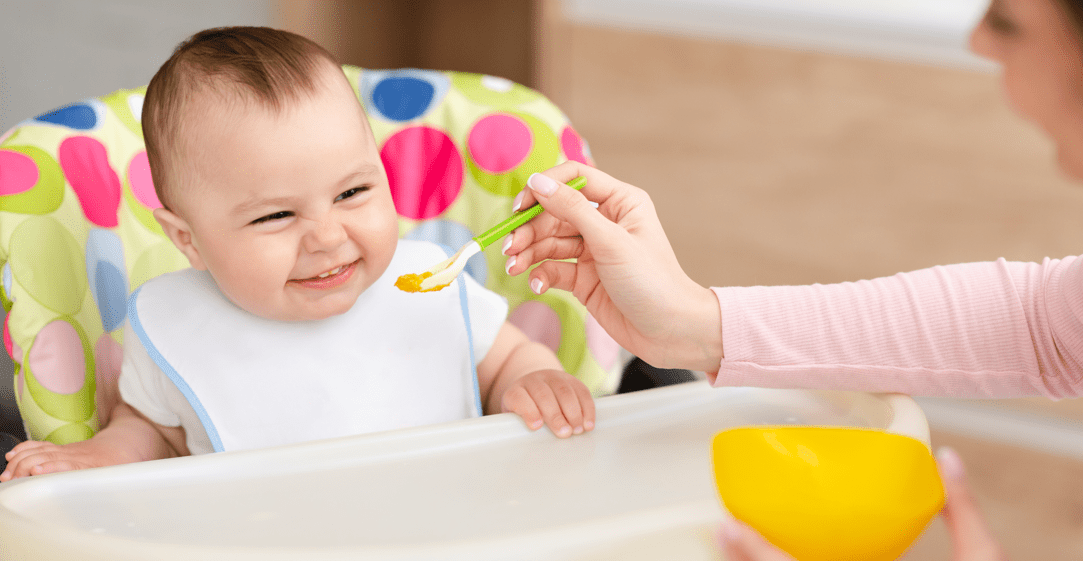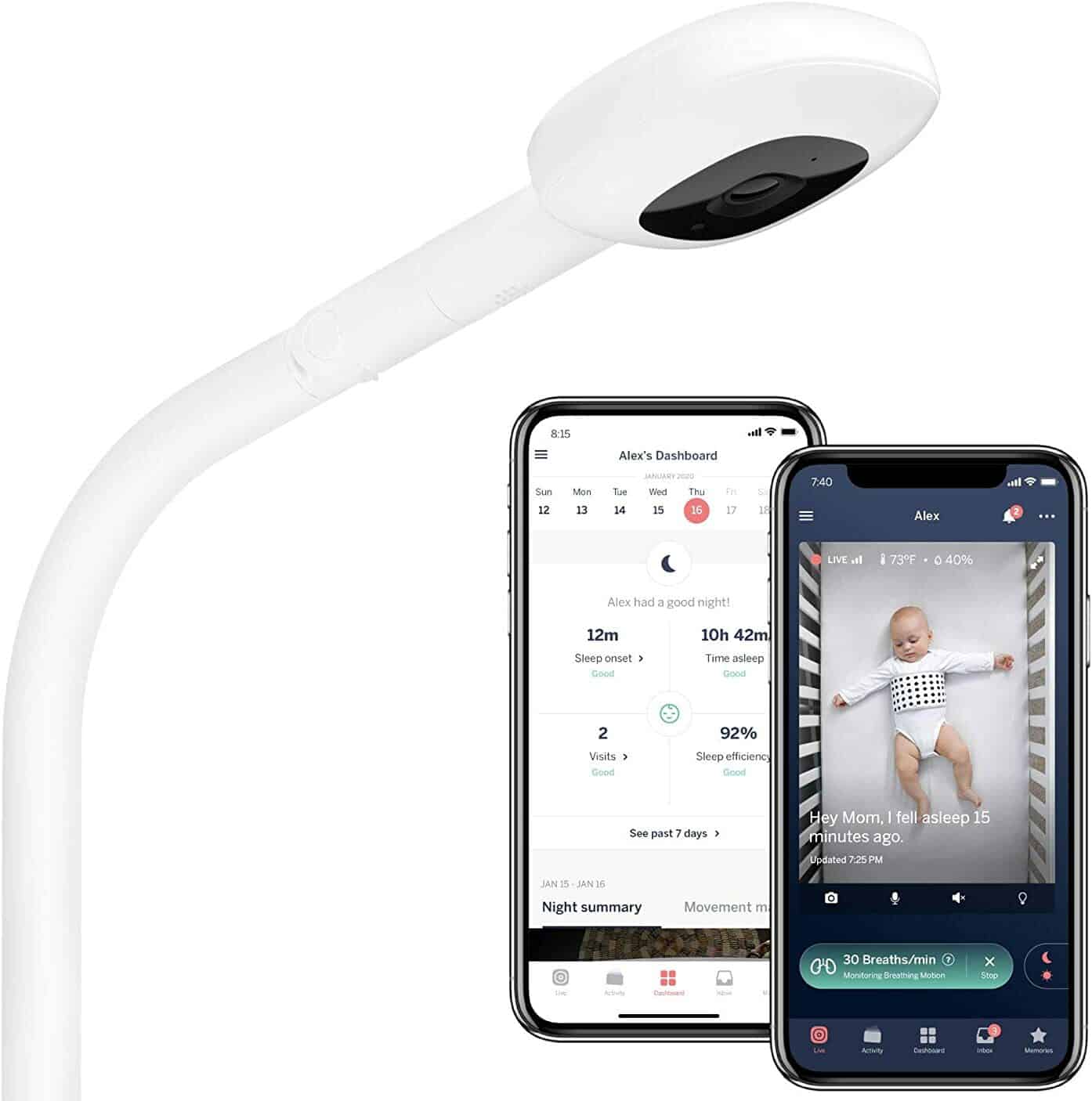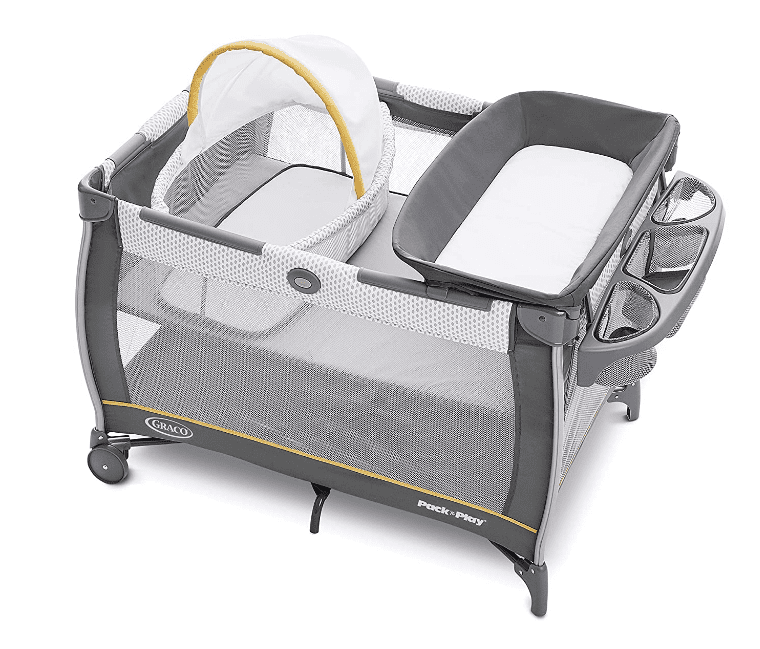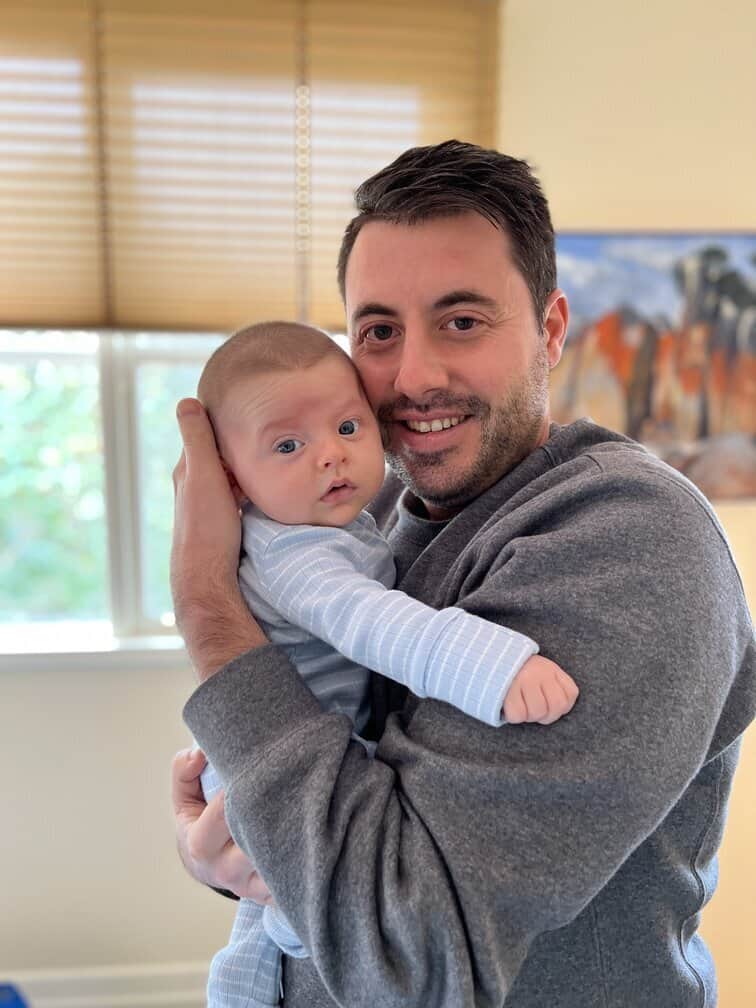Seven months is the time of great achievements in your little one’s development. Our son could already roll from side to side, fully sit up unassisted, and even made the first bold attempts at crawling across the room. But we were a bit lost when it came to our 7-months-old sleep schedule.
Are you wondering how much your little one should sleep at this age? Would you like to adjust their sleep schedule but don’t know how to do it? Could you use the help of accessories designed to make their sleep easier, calmer, or deeper? This article will provide you with lots of useful and hopefully helpful information and share some interesting 7 Month Old sleep schedule ideas.
First, let’s start with a brief overview of our children’s sleep patterns at this specific age in general.
How Many Hours a Day Should A 7-Month-Old Baby Sleep?
Based on the American Academy of Sleep Medicine’s recommendations, your 7-month-old baby should sleep about 14 hours a day. It’s less than before (see our 3-month-old-baby sleep schedule ideas article), but still more than half of the day.
Of course, babies are not identical. Our boy, for example, slept altogether only about 13 hours a day at this age and didn’t seem to miss the additional hour at all. On the contrary, other kids need more sleep to rest fully. As our pediatrician advised, these differences are perfectly fine.
It was somewhat more complicated for us to understand how to appropriately distribute this total number of hours of sleep throughout the day so that our son is happy and rested while we can go on with our daily activities as needed.
That’s why I started looking into the possibilities of adjusting our baby’s sleep schedule.
Can You Get Your 7-Month-Old On a Sleep Schedule?
While pediatricians advise against setting your newborn on a tight sleep schedule during the first months of their lives, at seven months, babies are usually already capable of some sensitive and reasonable sleep training.
But before you create your own “ideal” sleep schedule, you should understand how many (and how long) day naps your baby needs.
While at 10-12 months, most babies do not nap more than twice during the day, children at seven months can differ. Our friends, for example, couldn’t get their son to nap once before lunch and once in the afternoon. He was just too active.
Our son, on the contrary, perfectly enjoyed three naps a day at this age. Nevertheless, it took us a while to figure out their perfect timing – especially given that at the same time, we were introducing him to solid food and needed to schedule the meals around his sleep time too.
Let’s take a look at two sample sleep schedules you can try with your baby right away, depending on how many naps per they are they currently used to.
Sample Sleep Schedules For 7-Month-Old
As I’ve already mentioned, your little one’s timetable at this age primarily revolves around the significant changes in their eating habits.
Whether your baby is breastfed or on formula, seven months of age is a time when solids start to play an important role in their diet.
That can come with various changes in their behavior, mood, and well-being, too – especially if they eat something new and struggle with digestion. That’s why the following sample schedules also include tips on timing your meals.
Example no. 1: Two Naps Version
The following schedule is ideal for the 7-month-olds who can already do with two daily naps only:
| 7:00 AM | Morning rise followed by breastfeeding or formula |
| 8:00 AM | Solid breakfast |
| 9:30 – 11:00 AM | First nap of the day |
| 11:15 AM | Breastfeeding or formula |
| 12:30 PM | Breastfeeding or formula |
| 2:00 – 3:30 PM | Second nap of the day |
| 3:45 PM | Breastfeeding or formula |
| 5:00 PM | Solid dinner |
| 6:30 PM | Begin your daily bedtime routine |
| 7:00 PM | Breastfeeding or formula and bedtime |
Example no. 2: Three Naps Version
If your baby likes to have more naps during the day (like our son), try this version of the schedule with three daily naps:
| 7:00 AM | Morning rise followed by breastfeeding or formula |
| 8:00 AM | Solid breakfast |
| 9:30 – 10:30 AM | First nap of the day |
| 11:15 AM | Breastfeeding or formula |
| 12:30 – 1:30 PM | Second nap of the day |
| 1:45 PM | Breastfeeding or formula |
| 4:00 – 4:45 PM | Third nap of the day (aim to make it slightly shorter) |
| 5:00 PM | Solid dinner |
| 6:30 PM | Begin your daily bedtime routine |
| 7:00 PM | Breastfeeding or formula and bedtime |
Sleep Schedule Ideas To Improve Your 7-Month-Old’s Sleep
The schedules above represent an ideal timeframe you may try to achieve and maintain daily. But we all know that “life happens” – sometimes things don’t go as planned and you have to improvize or look for other factors that might need some improvement.
If you’re struggling to keep up with the ideal sleep schedule, maybe some of the following tips (mostly coming from my personal experience) will help you.
1. Consistency
So, you’ve finally agreed on a suitable sleep schedule for your little one, tried to put it into practice – and it failed. Now what?
Before you start doing everything differently from scratch, remember that one of the most important prerequisites of success is consistency.
Give your newly set schedule at least a week of consistent attempts. Your baby may just need some time to adjust to the new reality.
2. Priorities
Some 7-month-old babies can already sleep throughout the night without waking up for feeding and cuddles (our boy, however, needed more time to get there).
But whether your baby does or does not have this ability already, remember that a good, uninterrupted night’s sleep is your ultimate goal in the long run. Everything else can be more or less adjusted.
If your baby has trouble falling asleep in the evening, maybe it’s time to make their afternoon naps shorter or try missing the third nap altogether. Or put them to sleep slightly later, so they have more time to get tired naturally.
3. Happy Tummy
Some babies have to be persuaded to eat solids. Our boy, however, was eager to try all the new flavors and often asked for larger portions than he was supposed to get, according to the charts.
We were happy to see him eating well, but sometimes his appetite seemed to interfere with his night’s sleep. We had to choose either lighter meals, smaller portions, or earlier feeding since he apparently couldn’t sleep well while his tummy was still working on digestion.
Avoid the opposite extreme, too: A hungry baby will not sleep well either. They will most likely wake up during the night more frequently.
4. Activity
As our babies grow, they start spending their awake time much more active because their physical power, motor skills, sensory abilities, and cognition develop rapidly.
On the other hand, remember that they will also need more action to become tired as they develop. Just like you may have problems falling asleep after a lazy day on the couch, you can expect your baby to have a hard time sleeping if they spend most of their day just lying in their crib.
Of course, overstimulation can also be problematic. Avoid flashy lights, loud sounds, and dynamic physical activities for at least 30 minutes before starting your bedtime routine.
5. Comfort
Earlier, when my son was exhausted, he could sleep literally anywhere, regardless of his current position, noise, light, and temperature. However, once we adjusted him to a set sleep schedule, he became much more demanding on his comfort.
If your baby seems to be frustrated when you’re trying to put them to sleep, check if their bed and nursery provide them with all the comfort they need. Darkening the windows, adding more humidity, or replacing too thin mattresses can sometimes resolve the problem.
7-Moth-Old Sleep Schedule: Three Products You May Appreciate
A piece of good theoretical advice is sometimes not enough. Here are three products that practically helped us with our 7-months-old son’s sleep schedule. Maybe they’ll help you too.
1. A Smart Baby Monitor Such As Nanit Pro
A good baby monitor can give you an unbeatable overview of your little one’s sleep quality – and also great peace of mind.
We choseNanit Pro – an intelligent monitor with full-HD video, a very convenient bird view thanks to the included stand, and two-way audio that allowed us to start soothing our son remotely even before we got to his nursery.
It also allows you to monitor the temperature and humidity in the room and track the baby’s sleep through sophisticated statistics. It is pretty expensive, though.
Further Reading
2. A Quality Playpen Such As Graco Pack N Play
As our son grew, he spent more and more time actively playing. He also became much more demanding of our attention, always ensuring that we were around him, looking at what he was doing, and appreciating his discoveries and achievements.
A portable Pack N Play (we currently haveGraco Pack’ n Play Care Suite) was an excellent solution. It allows you to move your baby around the house wherever you need to be at the moment and assist them with playing while doing your chores or taking care of their siblings.
Moreover, it is also perfectly safe for your baby’s nap, so it makes the whole process of getting your little one to sleep once they get tired from playing faster and easier.
Further Reading
3. A Darkening Tent Such as SlumberPod
As I’ve already mentioned, when we started adapting our son to a set sleep schedule, he seemed to become much more sensitive to his comfort and environment. While he used to be perfectly fine with daylight earlier, he was suddenly fussy when the room was not completely dark.
We have tried several decent detachable window blinds. Still, we found a universal solution that we could also use during our travels:SlumberPod. This top darkening tent fits over your playpen/travel cot and provides your baby with complete darkness and peace.
It is perfectly breathable and very safe. It also has a pouch for a baby monitor inside, which I found particularly thoughtful.
Use the DISCOUNT code “UPSIDEDAD” for $20 OFF or click the button below for your EXCLUSIVE discount!
Further Reading
FAQs
Question: How long should a 7-month-old be awake between naps?
Answer: Most babies at this age can stay active for about 2 to 3 hours between their day naps. However, if you see that your baby is exhausted sooner, do not wait and allow them to rest before they get frustrated.
Question: How many times should a 7-month-old wake up at night?
Answer: Some 7-month-old babies can already sleep throughout the night (or at least fall asleep on their own again without waking you up). Others, however, may still require to be fed at least once or twice at night.
Question: What time should 7 month old go to bed?
Answer: Infants should go to bed around 7 or 8 PM. This allows them a proper night’s sleep corresponding with their parents.
Conclusion: You’ve got this!
Setting your infant on a sleep schedule may seem scary at first. In practice, however, you’ll probably soon discover that there’s not much to worry about.
After all, you don’t want your baby to do anything unnatural – you’re just helping them to adapt to a well-balanced cycle of fun and rest they will benefit from the most.
The good news is that when your baby is seven months, they can already distinguish between day and night. They can also sleep longer and tighter during the night, and they’re much more physically active during the day, which makes them inherently tired and sleepy when it’s time to rest.
Taking advantage of these natural factors, you can certainly pull off their sleep schedule without any major obstacles.
Read also:
- Newborn Sleep Schedule Ideas
- 2-Month-Old Sleep Schedule Ideas
- 3-Month-Old Slee Schedule Ideas
- 4-Month Old Sleep Schedule Ideas
- 6-Month-Old Sleep Schedule Ideas
- 7-Month-Old Sleep Schedule Ideas
- 10 Month Old Sleep Schedule Ideas
As a new dad himself, David understands the struggles in dealing with a newborn’s sleep schedule. He knows how hard it is to work and deal with a lack of sleep at night. He thoroughly tests out products and can advise which are best for your little one. In his spare time, he enjoys riding ATVs and BMX.










